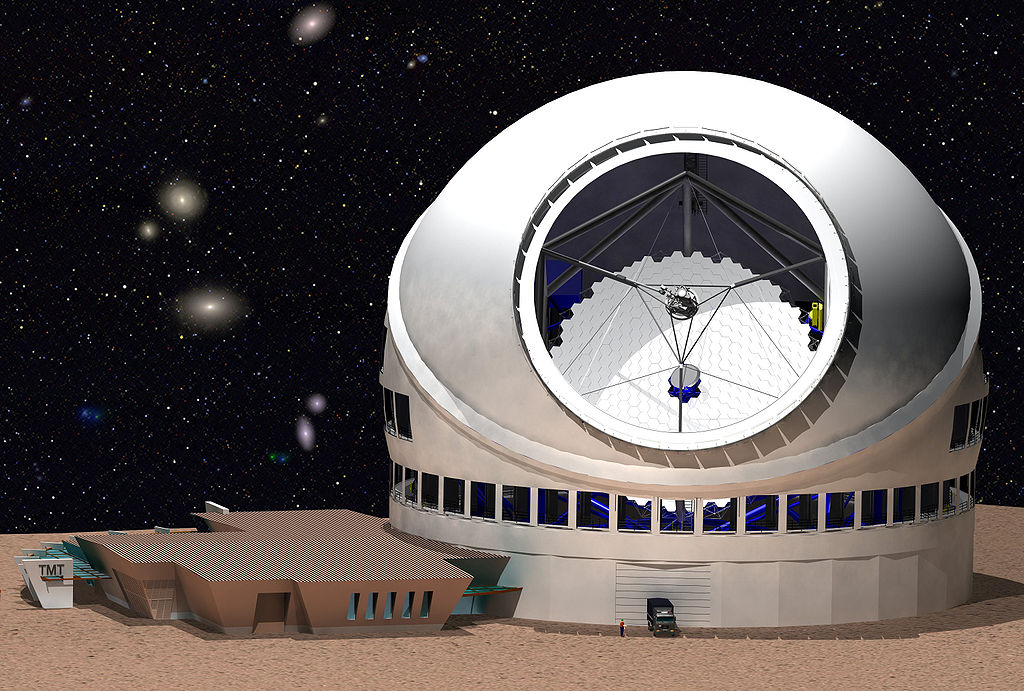【翻译】巨型望远镜:要继续,就得有牺牲!
By 苏剑林 | 2015-06-10 | 24268位读者 |文章来自:新科学家,这是一篇关于30米望远镜(Thirty Meter Telescope,TMT)的新闻,起因是望远镜的制造遭到当地人的不满,当然背后的原因是很深远的,难以说清楚。更多有关TMT的新闻,可以阅读:http://www.ctmt.org/
夏威夷的巨型望远镜:要继续,就得有牺牲! #
四分之一必须离开!在停止了两个月之后,夏威夷的巨型30米望远镜(Thirty Meter Telescope,TMT)重新回归到建设进程——但要牺牲其他望远镜。
由于夏威夷当地居民的抗议声越来越大,早在四月望远镜的建设工作就被迫暂停。与该望远镜相比,目前世界上所有的望远镜都相形见绌——它让能够让天文学家们凝视可见的宇宙的边缘。它位于许多夏威夷人认为是“神圣之地”的死火山莫纳克亚山,因此被夏威夷人认为是一种侮辱——尤其是在山顶已经有十多个望远镜了。
“在1960年代天文学家们第一次来莫纳克亚山建台的时候,我们就开始关心这一问题,”夏威夷活动者Kealoha Pisciotta说,“但直到早些日子,夏威夷居民都被压迫着,并没有听到他们的任何声音。”
现在声音已经被听到了:5月26日,夏威夷州长David Ige宣布TMT的建造可以恢复,条件是在2020年中期望远镜进入运作之时,山顶上现有的13个望远镜之中至少要关闭掉四分之一。
不仅如此,到2033年,负责山顶天文观测操作的夏威夷大学,不能再续租当前在租的45平方公里区域中的40平方公里,同时还要保证不再在其它未发展的地方建设望远镜。另外,从现在开始,所有想要到4205米峰顶一览的游客,不仅会收到高原反应的警告,还需要接受有关该山的文化价值的培训。
山上的加州理工学院的亚毫米波望远镜,在拆迁期之前就有新的望远镜来代替它了,但除了它之外,没有人知道莫纳克亚山上现有的其余12个望远镜哪几个会被关闭。几乎可以肯定的是,两个凯克望远镜,即双子望远镜和斯巴鲁望远镜——它们都是地球上最强大的望远镜——都会被保留下来。只有这样,才能使得天文学的损失最小化。
然而,这对天文学家的启发是巨大的。一些天文学家无视他们的抗议,仅仅当他们是无理取闹者,但另外一些开始从另外的角度看待这件事情,得到更深远的认识。
“我有点尬尴,因为我没想过天文学会给夏威夷居民带来如此影响,”刚在普林斯顿完成了博士后工作的Renée Hlozek表示,“我们不得不作出一些牺牲,但作为一个社区来说,我们并没有什么牺牲。”
哈佛大学史密森天体物理中心的天文学家John Johnson进一步表示,当他第一次听到抗议的时候,他并没有真正理解夏威夷居民如此不安的原因。“然后,”他说,“我开始去查阅历史。”他被震惊了。“没有被提及到的是,夏威夷本来是个主权国家,有着自己丰富的文化,但被(美国)抢了,而我们如今更是在毁灭它。对天文学家来说这仅仅是过去的事情,与我们无关,但仍让人觉得害怕。”
原文 #
Giant telescope in Hawaii gets go-ahead, if others shut down
One in four must go. Hawaii's giant Thirty Meter Telescope (TMT) is back in business after a hiatus of 2 months – but at the expense of other telescopes.
Back in April, construction of the telescope was temporarily halted in the face of mounting protests from native Hawaiians. The telescope would dwarf any observatory now in existence, allowing astronomers to peer to the very edge of the visible universe. Its presence atop the extinct volcano Mauna Kea, however, which many Hawaiians consider sacred ground, was considered an insult – especially since there are more than a dozen telescopes on the summit already.
"When astronomers first came build on Mauna Kea in the 1960s we were concerned," says Hawaiian activist Kealoha Pisciotta, "but back in the day Hawaiian people were oppressed and didn't have a voice."
That voice has now been heard: On 26 May, Hawaii's governor David Ige announced that construction on the TMT could resume. But by the time the telescope goes into operation in the mid-2020s, at least one-quarter of the 13 telescopes now on the summit must be shut down.
Not only that: by 2033, the University of Hawaii, which oversees astronomical operations on the summit, will have to abandon 40 of the 45 square kilometres it leases from the state, and promise not to build telescopes on any undeveloped land. And anyone who visits the 4205-metre summit from now on will not only get warnings about altitude sickness, but will also receive training on the peak's cultural significance.
No one knows which of the 13 telescopes on Mauna Kea will be shut down, apart from the Caltech Submillimeter Observatory, which had been scheduled for demolition even before the controversy over the new telescope arose. It's virtually certain that the twin Keck Telescopes, the Gemini Telescope and the Subaru telescope, all of which are among the most powerful on Earth, will survive. The overall harm to astronomy will be minimal.
The educational value for astronomers, however, could be enormous. Some have dismissed the protests as just a lot of noise from troublemakers, but others have found the episode eye-opening.
"I'm a little embarrassed that I hadn't even thought about the impact astronomy has had on indigenous Hawaiians," says Renée Hlozek, who is just finishing up a postdoctoral fellowship at Princeton. "We'll have to make some sacrifices, but as a community we haven't been on the receiving end of sacrifice."
John Johnson, an astronomer at the Harvard-Smithsonian Center for Astrophysics, goes even further. When he first heard about the protests, Johnson didn't really understand why the Hawaiians were so upset.
"Then," he says, "I began looking into the history." He was appalled. "It's not talked about, but [the US] stole the Hawaiian islands from a sovereign nation that had its own rich culture, and we just destroyed it. For astronomers to act like this is all in the past has nothing to do with us and is just horrible."
转载到请包括本文地址:https://www.spaces.ac.cn/archives/3354
更详细的转载事宜请参考:《科学空间FAQ》
如果您还有什么疑惑或建议,欢迎在下方评论区继续讨论。
如果您觉得本文还不错,欢迎分享/打赏本文。打赏并非要从中获得收益,而是希望知道科学空间获得了多少读者的真心关注。当然,如果你无视它,也不会影响你的阅读。再次表示欢迎和感谢!
如果您需要引用本文,请参考:
苏剑林. (Jun. 10, 2015). 《【翻译】巨型望远镜:要继续,就得有牺牲! 》[Blog post]. Retrieved from https://www.spaces.ac.cn/archives/3354
@online{kexuefm-3354,
title={【翻译】巨型望远镜:要继续,就得有牺牲!},
author={苏剑林},
year={2015},
month={Jun},
url={\url{https://www.spaces.ac.cn/archives/3354}},
}











June 21st, 2015
之前听说过一个故事,好像是基特峰天文台吧,修建之前带反对建台的原住民用望远镜观察星空,最终原住民同意修建天文台,并表示天文学研究是对自然的尊重。不知道这种和谐的模式能不能复制。
这种模式不错,但是估计挺难复制的,因为夏威夷的文化冲突比其他比方严重地多,也深沉得多。他们所反对的,不仅仅是对自然的不尊重,而更多是对他们自己的不尊重。